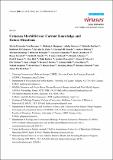Files in this item
Cetacean morbillivirus : current knowledge and future directions
Item metadata
| dc.contributor.author | Van Bressem, M.-F. | |
| dc.contributor.author | Duignan, P.J. | |
| dc.contributor.author | Banyard, A. | |
| dc.contributor.author | Barbieri, M. | |
| dc.contributor.author | Colegrove, K.M. | |
| dc.contributor.author | de Guise, S. | |
| dc.contributor.author | di Guardo, G. | |
| dc.contributor.author | Dobson, A. | |
| dc.contributor.author | Domingo, M. | |
| dc.contributor.author | Fauquier, D. | |
| dc.contributor.author | Fernandez, A. | |
| dc.contributor.author | Goldstein, T. | |
| dc.contributor.author | Grenfell, B. | |
| dc.contributor.author | Groch, K.R. | |
| dc.contributor.author | Gulland, F. | |
| dc.contributor.author | Jensen, B.A. | |
| dc.contributor.author | Jepson, P.D. | |
| dc.contributor.author | Hall, A. | |
| dc.contributor.author | Kuiken, T. | |
| dc.contributor.author | Mazzariol, S. | |
| dc.contributor.author | Morris, S.E. | |
| dc.contributor.author | Nielsen, O. | |
| dc.contributor.author | Raga, J.A. | |
| dc.contributor.author | Rowles, T.K. | |
| dc.contributor.author | Saliki, J. | |
| dc.contributor.author | Sierra, E. | |
| dc.contributor.author | Stephens, N. | |
| dc.contributor.author | Stone, B. | |
| dc.contributor.author | Tomo, I. | |
| dc.contributor.author | Wang, J. | |
| dc.contributor.author | Waltzek, T. | |
| dc.contributor.author | Wellehan, J.F.X. | |
| dc.date.accessioned | 2015-01-14T15:31:05Z | |
| dc.date.available | 2015-01-14T15:31:05Z | |
| dc.date.issued | 2014-12-22 | |
| dc.identifier | 161868014 | |
| dc.identifier | 7697a434-1429-4293-9f9c-701be7014cec | |
| dc.identifier | 84919820072 | |
| dc.identifier | 000346834500017 | |
| dc.identifier.citation | Van Bressem , M-F , Duignan , P J , Banyard , A , Barbieri , M , Colegrove , K M , de Guise , S , di Guardo , G , Dobson , A , Domingo , M , Fauquier , D , Fernandez , A , Goldstein , T , Grenfell , B , Groch , K R , Gulland , F , Jensen , B A , Jepson , P D , Hall , A , Kuiken , T , Mazzariol , S , Morris , S E , Nielsen , O , Raga , J A , Rowles , T K , Saliki , J , Sierra , E , Stephens , N , Stone , B , Tomo , I , Wang , J , Waltzek , T & Wellehan , J F X 2014 , ' Cetacean morbillivirus : current knowledge and future directions ' , Viruses , vol. 6 , no. 12 , pp. 5145-5181 . https://doi.org/10.3390/v6125145 | en |
| dc.identifier.issn | 1999-4915 | |
| dc.identifier.other | ORCID: /0000-0002-7562-1771/work/47136299 | |
| dc.identifier.uri | https://hdl.handle.net/10023/5996 | |
| dc.description.abstract | We review the molecular and epidemiological characteristics of cetacean morbillivirus (CeMV) and the diagnosis and pathogenesis of associated disease, with six different strains detected in cetaceans worldwide. CeMV has caused epidemics with high mortality in odontocetes in Europe, the USAand Australia. It represents a distinct species within the Morbillivirusgenus. Although most CeMV strains are phylogenetically closely related, recent data indicate that morbilliviruses recovered from Indo-Pacific bottlenose dolphins (Tursiops aduncus), from Western Australia, and a Guiana dolphin (Sotalia guianensis), from Brazil, are divergent. The signaling lymphocyte activation molecule (SLAM) cell receptor for CeMV has been characterized in cetaceans. It shares higher amino acid identity with the ruminant SLAM than with the receptors of carnivores or humans, reflecting the evolutionary history of these mammalian taxa. In Delphinidae, three amino acid substitutions may result in a higher affinity for the virus. Infection is diagnosed by histology, immunohistochemistry, virus isolation, RT-PCR, and serology. Classical CeMV-associated lesions include bronchointerstitial pneumonia, encephalitis, syncytia, and lymphoid depletion associated with immunosuppression. Cetaceans that survive the acute disease may develop fatal secondary infections and chronic encephalitis. Endemicallyinfected, gregarious odontocetes probably serve as reservoirs and vectors. Transmission likely occurs through the inhalation of aerosolized virus but mother to fetus transmission was also reported. | |
| dc.format.extent | 37 | |
| dc.format.extent | 2605156 | |
| dc.language.iso | eng | |
| dc.relation.ispartof | Viruses | en |
| dc.subject | Cetacean morbillivirus | en |
| dc.subject | Epidemics | en |
| dc.subject | Mass stranding | en |
| dc.subject | SLAM | en |
| dc.subject | Phylogeny | en |
| dc.subject | Pathogenesis | en |
| dc.subject | Diagnosis | en |
| dc.subject | Endemic infections | en |
| dc.subject | QH301 Biology | en |
| dc.subject | QR355 Virology | en |
| dc.subject.lcc | QH301 | en |
| dc.subject.lcc | QR355 | en |
| dc.title | Cetacean morbillivirus : current knowledge and future directions | en |
| dc.type | Journal article | en |
| dc.contributor.sponsor | NERC | en |
| dc.contributor.institution | University of St Andrews. School of Biology | en |
| dc.contributor.institution | University of St Andrews. Sea Mammal Research Unit | en |
| dc.contributor.institution | University of St Andrews. Marine Alliance for Science & Technology Scotland | en |
| dc.contributor.institution | University of St Andrews. Scottish Oceans Institute | en |
| dc.identifier.doi | https://doi.org/10.3390/v6125145 | |
| dc.description.status | Peer reviewed | en |
| dc.identifier.grantnumber | Agreement R8-H12-86 | en |
This item appears in the following Collection(s)
Items in the St Andrews Research Repository are protected by copyright, with all rights reserved, unless otherwise indicated.

